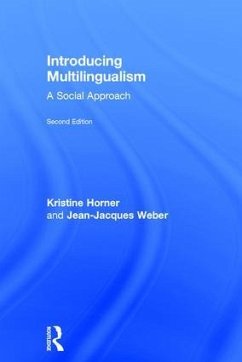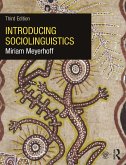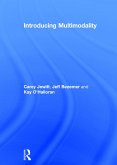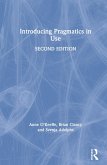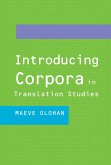- Gebundenes Buch
- Merkliste
- Auf die Merkliste
- Bewerten Bewerten
- Teilen
- Produkt teilen
- Produkterinnerung
- Produkterinnerung
Introducing Multilingualism is a comprehensive and user-friendly introduction to the dynamic field of multilingualism.
Andere Kunden interessierten sich auch für
![Introducing Sociolinguistics Introducing Sociolinguistics]() Miriam MeyerhoffIntroducing Sociolinguistics40,99 €
Miriam MeyerhoffIntroducing Sociolinguistics40,99 €![Introducing Needs Analysis and English for Specific Purposes Introducing Needs Analysis and English for Specific Purposes]() James Dean BrownIntroducing Needs Analysis and English for Specific Purposes180,99 €
James Dean BrownIntroducing Needs Analysis and English for Specific Purposes180,99 €![Introducing Electronic Text Analysis Introducing Electronic Text Analysis]() Svenja AdolphsIntroducing Electronic Text Analysis187,99 €
Svenja AdolphsIntroducing Electronic Text Analysis187,99 €![Introducing Multimodality Introducing Multimodality]() Carey JewittIntroducing Multimodality187,99 €
Carey JewittIntroducing Multimodality187,99 €![Introducing Pragmatics in Use Introducing Pragmatics in Use]() Anne O'KeeffeIntroducing Pragmatics in Use150,99 €
Anne O'KeeffeIntroducing Pragmatics in Use150,99 €![Introducing the Language of the News Introducing the Language of the News]() M Grazia BusaIntroducing the Language of the News188,99 €
M Grazia BusaIntroducing the Language of the News188,99 €![Introducing Corpora in Translation Studies Introducing Corpora in Translation Studies]() Maeve OlohanIntroducing Corpora in Translation Studies187,99 €
Maeve OlohanIntroducing Corpora in Translation Studies187,99 €-
-
-
Introducing Multilingualism is a comprehensive and user-friendly introduction to the dynamic field of multilingualism.
Hinweis: Dieser Artikel kann nur an eine deutsche Lieferadresse ausgeliefert werden.
Hinweis: Dieser Artikel kann nur an eine deutsche Lieferadresse ausgeliefert werden.
Produktdetails
- Produktdetails
- Verlag: Taylor & Francis
- 2nd edition
- Seitenzahl: 308
- Erscheinungstermin: 8. September 2017
- Englisch
- Abmessung: 234mm x 156mm x 19mm
- Gewicht: 630g
- ISBN-13: 9781138244481
- ISBN-10: 1138244481
- Artikelnr.: 49131547
- Herstellerkennzeichnung
- Libri GmbH
- Europaallee 1
- 36244 Bad Hersfeld
- gpsr@libri.de
- Verlag: Taylor & Francis
- 2nd edition
- Seitenzahl: 308
- Erscheinungstermin: 8. September 2017
- Englisch
- Abmessung: 234mm x 156mm x 19mm
- Gewicht: 630g
- ISBN-13: 9781138244481
- ISBN-10: 1138244481
- Artikelnr.: 49131547
- Herstellerkennzeichnung
- Libri GmbH
- Europaallee 1
- 36244 Bad Hersfeld
- gpsr@libri.de
Kristine Horner is Reader in Luxembourg Studies and Multilingualism at the University of Sheffield, where she is also Director of the Centre for Luxembourg Studies. Her upcoming publications include a new edition of The German-speaking World (2018). Jean-Jacques Weber is Professor of English and Education at the University of Luxembourg. His most recent book publications are Language Racism (2015) and Flexible Multilingual Education: Putting Children's Needs First (2014).
Acknowledgements
Part I: Theoretical and methodological considerations
Chapter 1: Introduction
A social approach to multilingualism
A note on terminology
Coping with change
How the book is structured
Chapter 2: Theoretical and methodological framework
The construction of meaning
Dominant vs. critical readings
Towards an ethnographically based discourse analysis
The study of language ideologies
Conclusion
Part II: Multilingualism within and across languages
Chapter 3: What is a language?
Discourse models of language
What is standard English?
'English' is a mere label
The fuzzy boundaries of named languages
Consequences for teaching
Consequences for research
Conclusion
Chapter 4: Language variation and the spread of global languages
African-American English
Caribbean 'nation language'
Singlish
The global spread of English
Two French youth languages
Conclusion
Chapter 5: Revitalization of endangered languages
Australian Aboriginal languages: a history of oppression
M¿ori in New Zealand: a revitalization success story
Sámi and Kven in Norway: differential positionings on the success-failure
continuum
Hebrew in Israel: the costs of revitalization
Breton in France: how (not) to standardize
Corsican and the polynomic paradigm
Conclusion
Part III: Societal and individual multilingualism
Chapter 6: Societal multilingualism
Ukraine
Switzerland
Singapore
Hong Kong and China
South Africa
Nigeria
Conclusion
Chapter 7: Language and identities
Categorization
Gee's four ways to view identity
Identity: a peach or an onion?
Ethnic and national identity
Code-switching and identity
Translanguaging identities
Conclusion
Chapter 8: The interplay between individual and societal multilingualism
The Canadian policy of bilingualism and multiculturalism
Some consequences for First Nations people
Quebec francophone nationalism
Individual bilingualism through institutional monolingualism
Exclusion through French, inclusion through English
Shifting ideologies
Conclusion: the commodification of language
Part IV: Multilingualism in education and other institutional sites
Chapter 9: Flexible vs. fixed multilingualism
US vs. EU language-in-education policy
Case Study 1: Luxembourg
Case Study 2: Catalonia and the Basque Country
Discussion and conclusion: towards flexible multilingualism
Chapter 10: Mother tongue education or literacy bridges?
The case for mother tongue education: African-American English
The case against mother tongue education (in four steps): South Africa
The problems with mother tongue education
Towards literacy bridges
Conclusion: a possible solution for South Africa
Chapter 11: Heritage language education
From mother tongue education to heritage language education
Language and heritage in the United States
Language and heritage in England
The dominance of the standard language and purist ideologies
Discussion and conclusion: implications for the EU policy of
multilingualism
12 Multilingualism in other institutional sites
Multilingualism in the workplace
Multilingualism in legal settings and asylum procedures
Language use in multilingual families
Part V: Critical analysis of discourses
Chapter 13: Institutional discourses on language and migration
The discourse of integration
Language testing and citizenship
Conclusion: unpacking the discourses of integration and language testing
Chapter 14: Media representations of multilingualism
Past vs. present perceptions of multilingualism in the media
Firwat ass alles schief gaangen?: responses to Luxembourg's PISA results
Constructing the UK as an English-only space
The English Only movement in the US
Conclusion: a historical perspective on the one nation-one language
ideology
Chapter 15: Multilingualism in the new media
New media sociolinguistics
Digital ethnography
Language contact phenomena in digital language
The limited multilingualism of the Internet
Language policing in the social media
Conclusion
Chapter 16: Linguistic landscape
Limitations of (some) linguistic landscape analyses
Language contact phenomena on multilingual signs
Some basic distinctions
Contextualizing and historicizing linguistic landscapes
Exploring the context of reception
Discussion and conclusion: discourses in place
Part VI: Further directions in the study of multilingualism
Chapter 17: Conclusion
Further directions in the study of multilingualism
Moving into a multilingual future
Normalizing multilingualism
Notes on the activities
Notes on the quizzes
Author index
Subject index
Part I: Theoretical and methodological considerations
Chapter 1: Introduction
A social approach to multilingualism
A note on terminology
Coping with change
How the book is structured
Chapter 2: Theoretical and methodological framework
The construction of meaning
Dominant vs. critical readings
Towards an ethnographically based discourse analysis
The study of language ideologies
Conclusion
Part II: Multilingualism within and across languages
Chapter 3: What is a language?
Discourse models of language
What is standard English?
'English' is a mere label
The fuzzy boundaries of named languages
Consequences for teaching
Consequences for research
Conclusion
Chapter 4: Language variation and the spread of global languages
African-American English
Caribbean 'nation language'
Singlish
The global spread of English
Two French youth languages
Conclusion
Chapter 5: Revitalization of endangered languages
Australian Aboriginal languages: a history of oppression
M¿ori in New Zealand: a revitalization success story
Sámi and Kven in Norway: differential positionings on the success-failure
continuum
Hebrew in Israel: the costs of revitalization
Breton in France: how (not) to standardize
Corsican and the polynomic paradigm
Conclusion
Part III: Societal and individual multilingualism
Chapter 6: Societal multilingualism
Ukraine
Switzerland
Singapore
Hong Kong and China
South Africa
Nigeria
Conclusion
Chapter 7: Language and identities
Categorization
Gee's four ways to view identity
Identity: a peach or an onion?
Ethnic and national identity
Code-switching and identity
Translanguaging identities
Conclusion
Chapter 8: The interplay between individual and societal multilingualism
The Canadian policy of bilingualism and multiculturalism
Some consequences for First Nations people
Quebec francophone nationalism
Individual bilingualism through institutional monolingualism
Exclusion through French, inclusion through English
Shifting ideologies
Conclusion: the commodification of language
Part IV: Multilingualism in education and other institutional sites
Chapter 9: Flexible vs. fixed multilingualism
US vs. EU language-in-education policy
Case Study 1: Luxembourg
Case Study 2: Catalonia and the Basque Country
Discussion and conclusion: towards flexible multilingualism
Chapter 10: Mother tongue education or literacy bridges?
The case for mother tongue education: African-American English
The case against mother tongue education (in four steps): South Africa
The problems with mother tongue education
Towards literacy bridges
Conclusion: a possible solution for South Africa
Chapter 11: Heritage language education
From mother tongue education to heritage language education
Language and heritage in the United States
Language and heritage in England
The dominance of the standard language and purist ideologies
Discussion and conclusion: implications for the EU policy of
multilingualism
12 Multilingualism in other institutional sites
Multilingualism in the workplace
Multilingualism in legal settings and asylum procedures
Language use in multilingual families
Part V: Critical analysis of discourses
Chapter 13: Institutional discourses on language and migration
The discourse of integration
Language testing and citizenship
Conclusion: unpacking the discourses of integration and language testing
Chapter 14: Media representations of multilingualism
Past vs. present perceptions of multilingualism in the media
Firwat ass alles schief gaangen?: responses to Luxembourg's PISA results
Constructing the UK as an English-only space
The English Only movement in the US
Conclusion: a historical perspective on the one nation-one language
ideology
Chapter 15: Multilingualism in the new media
New media sociolinguistics
Digital ethnography
Language contact phenomena in digital language
The limited multilingualism of the Internet
Language policing in the social media
Conclusion
Chapter 16: Linguistic landscape
Limitations of (some) linguistic landscape analyses
Language contact phenomena on multilingual signs
Some basic distinctions
Contextualizing and historicizing linguistic landscapes
Exploring the context of reception
Discussion and conclusion: discourses in place
Part VI: Further directions in the study of multilingualism
Chapter 17: Conclusion
Further directions in the study of multilingualism
Moving into a multilingual future
Normalizing multilingualism
Notes on the activities
Notes on the quizzes
Author index
Subject index
Acknowledgements
Part I: Theoretical and methodological considerations
Chapter 1: Introduction
A social approach to multilingualism
A note on terminology
Coping with change
How the book is structured
Chapter 2: Theoretical and methodological framework
The construction of meaning
Dominant vs. critical readings
Towards an ethnographically based discourse analysis
The study of language ideologies
Conclusion
Part II: Multilingualism within and across languages
Chapter 3: What is a language?
Discourse models of language
What is standard English?
'English' is a mere label
The fuzzy boundaries of named languages
Consequences for teaching
Consequences for research
Conclusion
Chapter 4: Language variation and the spread of global languages
African-American English
Caribbean 'nation language'
Singlish
The global spread of English
Two French youth languages
Conclusion
Chapter 5: Revitalization of endangered languages
Australian Aboriginal languages: a history of oppression
M¿ori in New Zealand: a revitalization success story
Sámi and Kven in Norway: differential positionings on the success-failure
continuum
Hebrew in Israel: the costs of revitalization
Breton in France: how (not) to standardize
Corsican and the polynomic paradigm
Conclusion
Part III: Societal and individual multilingualism
Chapter 6: Societal multilingualism
Ukraine
Switzerland
Singapore
Hong Kong and China
South Africa
Nigeria
Conclusion
Chapter 7: Language and identities
Categorization
Gee's four ways to view identity
Identity: a peach or an onion?
Ethnic and national identity
Code-switching and identity
Translanguaging identities
Conclusion
Chapter 8: The interplay between individual and societal multilingualism
The Canadian policy of bilingualism and multiculturalism
Some consequences for First Nations people
Quebec francophone nationalism
Individual bilingualism through institutional monolingualism
Exclusion through French, inclusion through English
Shifting ideologies
Conclusion: the commodification of language
Part IV: Multilingualism in education and other institutional sites
Chapter 9: Flexible vs. fixed multilingualism
US vs. EU language-in-education policy
Case Study 1: Luxembourg
Case Study 2: Catalonia and the Basque Country
Discussion and conclusion: towards flexible multilingualism
Chapter 10: Mother tongue education or literacy bridges?
The case for mother tongue education: African-American English
The case against mother tongue education (in four steps): South Africa
The problems with mother tongue education
Towards literacy bridges
Conclusion: a possible solution for South Africa
Chapter 11: Heritage language education
From mother tongue education to heritage language education
Language and heritage in the United States
Language and heritage in England
The dominance of the standard language and purist ideologies
Discussion and conclusion: implications for the EU policy of
multilingualism
12 Multilingualism in other institutional sites
Multilingualism in the workplace
Multilingualism in legal settings and asylum procedures
Language use in multilingual families
Part V: Critical analysis of discourses
Chapter 13: Institutional discourses on language and migration
The discourse of integration
Language testing and citizenship
Conclusion: unpacking the discourses of integration and language testing
Chapter 14: Media representations of multilingualism
Past vs. present perceptions of multilingualism in the media
Firwat ass alles schief gaangen?: responses to Luxembourg's PISA results
Constructing the UK as an English-only space
The English Only movement in the US
Conclusion: a historical perspective on the one nation-one language
ideology
Chapter 15: Multilingualism in the new media
New media sociolinguistics
Digital ethnography
Language contact phenomena in digital language
The limited multilingualism of the Internet
Language policing in the social media
Conclusion
Chapter 16: Linguistic landscape
Limitations of (some) linguistic landscape analyses
Language contact phenomena on multilingual signs
Some basic distinctions
Contextualizing and historicizing linguistic landscapes
Exploring the context of reception
Discussion and conclusion: discourses in place
Part VI: Further directions in the study of multilingualism
Chapter 17: Conclusion
Further directions in the study of multilingualism
Moving into a multilingual future
Normalizing multilingualism
Notes on the activities
Notes on the quizzes
Author index
Subject index
Part I: Theoretical and methodological considerations
Chapter 1: Introduction
A social approach to multilingualism
A note on terminology
Coping with change
How the book is structured
Chapter 2: Theoretical and methodological framework
The construction of meaning
Dominant vs. critical readings
Towards an ethnographically based discourse analysis
The study of language ideologies
Conclusion
Part II: Multilingualism within and across languages
Chapter 3: What is a language?
Discourse models of language
What is standard English?
'English' is a mere label
The fuzzy boundaries of named languages
Consequences for teaching
Consequences for research
Conclusion
Chapter 4: Language variation and the spread of global languages
African-American English
Caribbean 'nation language'
Singlish
The global spread of English
Two French youth languages
Conclusion
Chapter 5: Revitalization of endangered languages
Australian Aboriginal languages: a history of oppression
M¿ori in New Zealand: a revitalization success story
Sámi and Kven in Norway: differential positionings on the success-failure
continuum
Hebrew in Israel: the costs of revitalization
Breton in France: how (not) to standardize
Corsican and the polynomic paradigm
Conclusion
Part III: Societal and individual multilingualism
Chapter 6: Societal multilingualism
Ukraine
Switzerland
Singapore
Hong Kong and China
South Africa
Nigeria
Conclusion
Chapter 7: Language and identities
Categorization
Gee's four ways to view identity
Identity: a peach or an onion?
Ethnic and national identity
Code-switching and identity
Translanguaging identities
Conclusion
Chapter 8: The interplay between individual and societal multilingualism
The Canadian policy of bilingualism and multiculturalism
Some consequences for First Nations people
Quebec francophone nationalism
Individual bilingualism through institutional monolingualism
Exclusion through French, inclusion through English
Shifting ideologies
Conclusion: the commodification of language
Part IV: Multilingualism in education and other institutional sites
Chapter 9: Flexible vs. fixed multilingualism
US vs. EU language-in-education policy
Case Study 1: Luxembourg
Case Study 2: Catalonia and the Basque Country
Discussion and conclusion: towards flexible multilingualism
Chapter 10: Mother tongue education or literacy bridges?
The case for mother tongue education: African-American English
The case against mother tongue education (in four steps): South Africa
The problems with mother tongue education
Towards literacy bridges
Conclusion: a possible solution for South Africa
Chapter 11: Heritage language education
From mother tongue education to heritage language education
Language and heritage in the United States
Language and heritage in England
The dominance of the standard language and purist ideologies
Discussion and conclusion: implications for the EU policy of
multilingualism
12 Multilingualism in other institutional sites
Multilingualism in the workplace
Multilingualism in legal settings and asylum procedures
Language use in multilingual families
Part V: Critical analysis of discourses
Chapter 13: Institutional discourses on language and migration
The discourse of integration
Language testing and citizenship
Conclusion: unpacking the discourses of integration and language testing
Chapter 14: Media representations of multilingualism
Past vs. present perceptions of multilingualism in the media
Firwat ass alles schief gaangen?: responses to Luxembourg's PISA results
Constructing the UK as an English-only space
The English Only movement in the US
Conclusion: a historical perspective on the one nation-one language
ideology
Chapter 15: Multilingualism in the new media
New media sociolinguistics
Digital ethnography
Language contact phenomena in digital language
The limited multilingualism of the Internet
Language policing in the social media
Conclusion
Chapter 16: Linguistic landscape
Limitations of (some) linguistic landscape analyses
Language contact phenomena on multilingual signs
Some basic distinctions
Contextualizing and historicizing linguistic landscapes
Exploring the context of reception
Discussion and conclusion: discourses in place
Part VI: Further directions in the study of multilingualism
Chapter 17: Conclusion
Further directions in the study of multilingualism
Moving into a multilingual future
Normalizing multilingualism
Notes on the activities
Notes on the quizzes
Author index
Subject index

